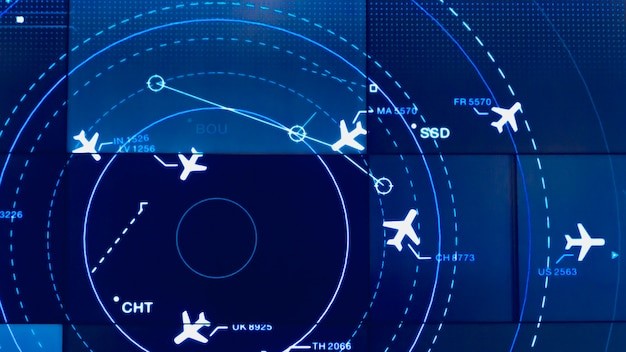Flight Information Region: Introduction
A flight information region (FIR) is an airspace of defined dimensions that provides:
- Flight information service
- Alerting services
FIRs are the world’s largest regular division of airspace in use today.
FIRs are integral to the safety and efficiency of air travel, providing vital services and organization within defined airspace regions.
What is Flight Information Region (FIR)

- A Flight Information Region (FIR) is an airspace of defined dimensions where flight information service and alerting services are provided.
- The largest regular divisions of airspace worldwide
- Existing since at least 1947
- FIRs, often abbreviated as FIRs, are specific airspace regions established to facilitate air traffic services. These services include flight information, alerting, and air traffic control. FIRs are typically designated by national aviation authorities or regulatory bodies and can cover both domestic and international airspace.
Functions of Flight Information Region
Air Traffic Control
- Within each FIR, air traffic controllers provide essential services such as:
- issuing clearances
- Managing aircraft movements
- Ensuring safe separation between flights.
Flight Information Services
- Pilots operating within FIRs receive valuable information about:
- Weather conditions
- Other air traffic
- Navigational aids
- Any potential hazards along their route
Alerting Services
- FIRs also serve as the primary point of contact for aircraft in distress.
- In case of emergencies, pilots can quickly relay information to air traffic controllers within the relevant FIR, initiating prompt:
- Response
- Assistance
Significance of Flight Information Region

Safety
- By dividing airspace into manageable regions, FIRs help prevent conflicts between aircraft and ensure safe separation.
- This structure minimizes the risk of mid-air collisions and other incidents.
Efficiency
- FIRs facilitate the smooth flow of air traffic by providing:
- Organized routes
- Clear communication channels,
- Effective coordination between different aviation stakeholders
International Coordination
- Since air travel often involves crossing multiple FIRs and national borders, international cooperation and coordination are essential.
- FIRs provide a framework for seamless integration of air traffic management systems on a global scale.
Global Airspace Division

- The world’s airspace is segmented into nine International Civil Aviation Organization (ICAO) air navigation regions, each with its FIRs.
- These regions play a critical role in global air traffic management.
These regions are as follows:
- Africa–Indian Ocean Region (AFI)
- Asia Region (ASIA)
- Caribbean Region (CAR)
- European Region (EUR)
- Middle East Region (MID)
- North American Region (NAM)
- North Atlantic Region (NAT)
- Pacific Region (PAC)
- South American Region (SAM)
Flight Information Region Management
- Each Flight Information Region (FIR) is managed by a controlling authority delegated by the International Civil Aviation Organization (ICAO).
- The controlling authority ensures air traffic services within the FIR, maintaining standardized procedures and safety protocols.
- FIR management includes operational control and responsibility for providing air traffic services to aircraft within the region.
Airspace Within a Flight Information Region
- Airspace within an FIR (and UIR) is typically divided into pieces that vary in function, size, and classification.
- These classifications determine the rules for flying within a piece of airspace and whether it is ‘controlled’ or ‘uncontrolled’.
FIR Size and Structure
- FIRs vary in size, with smaller countries typically having one FIR and larger ones having multiple regions.
- Airspace over the ocean is often divided into multiple FIRs, managed by countries bordering those regions.
- Additionally, FIRs may be vertically divided into Upper Information Regions (UIRs) for efficient airspace management.
Airspace Classification
- In some cases, FIRs are split vertically into lower and upper sections, with the lower section remaining referred to as a FIR, while the upper portion is referred to as an Upper Information Region (UIR).
- Airspace within an FIR is segmented based on various factors, including function, size, and classification.
- These classifications determine the rules for aircraft flying within specific airspace segments, ensuring safe separation and efficient air traffic flow.
Problems and Solutions
- FIRs play a crucial role in air traffic management, but they also pose challenges such as:
- Airspace congestion
- Coordination issues between neighboring states.
- International collaboration facilitated by the International Civil Aviation Organization (ICAO) helps address these challenges through:
- The development of regional procedures and solutions.
- Presentations by the ICAO Secretariat in recent years provide insights into complex FIR-related problems.
- Requiring collaboration among states within air navigation regions:
- to diagnose issues and propose amendments to:
- Doc 7030, Regional Supplementary Procedures
- to diagnose issues and propose amendments to:
Conclusion
- Flight Information Regions are the cornerstone of modern air traffic management, providing essential services and organization within the global airspace network.
- Understanding FIRs is crucial for pilots, air traffic controllers, and aviation enthusiasts alike, as they play a vital role in ensuring safe and efficient air travel worldwide.
- As technology advances and air travel evolves, FIRs will continue to adapt and innovate, remaining essential for the future of aviation.







